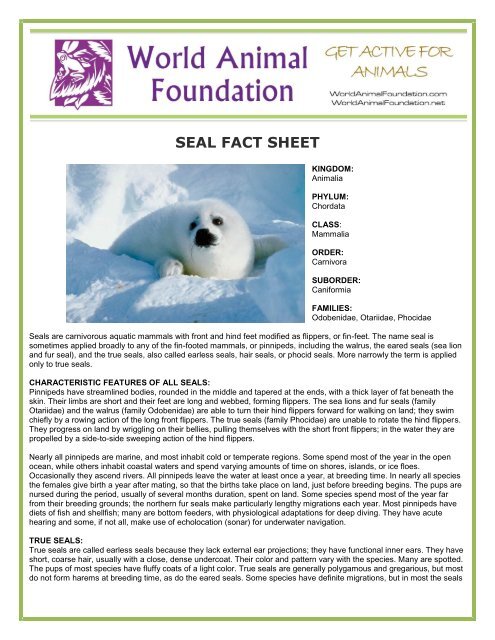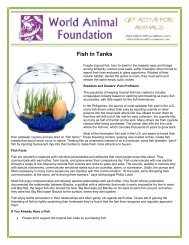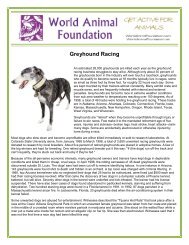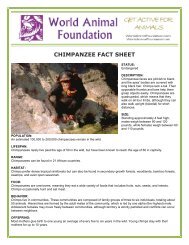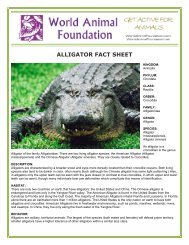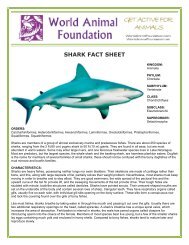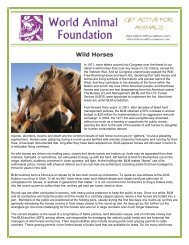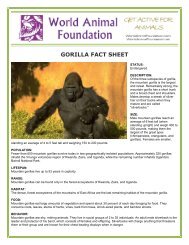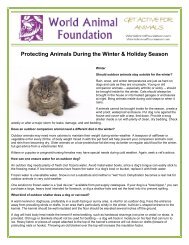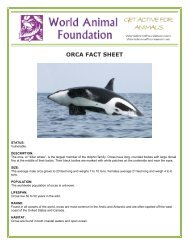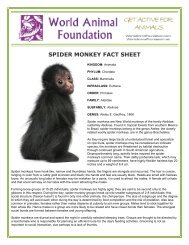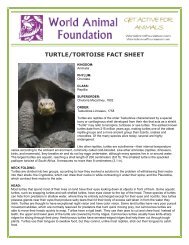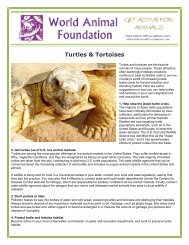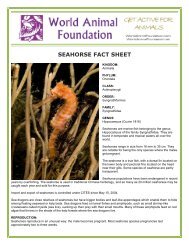SEAL FACT SHEET - World Animal Foundation
SEAL FACT SHEET - World Animal Foundation
SEAL FACT SHEET - World Animal Foundation
You also want an ePaper? Increase the reach of your titles
YUMPU automatically turns print PDFs into web optimized ePapers that Google loves.
<strong>SEAL</strong> <strong>FACT</strong> <strong>SHEET</strong><br />
KINGDOM:<br />
<strong>Animal</strong>ia<br />
PHYLUM:<br />
Chordata<br />
CLASS:<br />
Mammalia<br />
ORDER:<br />
Carnivora<br />
SUBORDER:<br />
Caniformia<br />
FAMILIES:<br />
Odobenidae, Otariidae, Phocidae<br />
Seals are carnivorous aquatic mammals with front and hind feet modified as flippers, or fin-feet. The name seal is<br />
sometimes applied broadly to any of the fin-footed mammals, or pinnipeds, including the walrus, the eared seals (sea lion<br />
and fur seal), and the true seals, also called earless seals, hair seals, or phocid seals. More narrowly the term is applied<br />
only to true seals.<br />
CHARACTERISTIC FEATURES OF ALL <strong>SEAL</strong>S:<br />
Pinnipeds have streamlined bodies, rounded in the middle and tapered at the ends, with a thick layer of fat beneath the<br />
skin. Their limbs are short and their feet are long and webbed, forming flippers. The sea lions and fur seals (family<br />
Otariidae) and the walrus (family Odobenidae) are able to turn their hind flippers forward for walking on land; they swim<br />
chiefly by a rowing action of the long front flippers. The true seals (family Phocidae) are unable to rotate the hind flippers.<br />
They progress on land by wriggling on their bellies, pulling themselves with the short front flippers; in the water they are<br />
propelled by a side-to-side sweeping action of the hind flippers.<br />
Nearly all pinnipeds are marine, and most inhabit cold or temperate regions. Some spend most of the year in the open<br />
ocean, while others inhabit coastal waters and spend varying amounts of time on shores, islands, or ice floes.<br />
Occasionally they ascend rivers. All pinnipeds leave the water at least once a year, at breeding time. In nearly all species<br />
the females give birth a year after mating, so that the births take place on land, just before breeding begins. The pups are<br />
nursed during the period, usually of several months duration, spent on land. Some species spend most of the year far<br />
from their breeding grounds; the northern fur seals make particularly lengthy migrations each year. Most pinnipeds have<br />
diets of fish and shellfish; many are bottom feeders, with physiological adaptations for deep diving. They have acute<br />
hearing and some, if not all, make use of echolocation (sonar) for underwater navigation.<br />
TRUE <strong>SEAL</strong>S:<br />
True seals are called earless seals because they lack external ear projections; they have functional inner ears. They have<br />
short, coarse hair, usually with a close, dense undercoat. Their color and pattern vary with the species. Many are spotted.<br />
The pups of most species have fluffy coats of a light color. True seals are generally polygamous and gregarious, but most<br />
do not form harems at breeding time, as do the eared seals. Some species have definite migrations, but in most the seals
spread out after breeding, singly or in groups, over a wide area of ocean. Some polar species migrate in winter to avoid<br />
the advancing ice; members of other species winter under the ice, surfacing through holes to breathe.<br />
Most true seal species fall into one of three geographical groups: northern, antarctic, and warm-water species. Nearly all<br />
are marine, but the Baykal seal (Pusa siberica) is confined to the freshwater Lake Baykal of Siberia, and the Caspian seal<br />
(P. caspica) to the brackish Caspian Sea. In addition, several populations of the normally marine harbor seals and ringed<br />
seals are found in freshwater lakes. The northern seals include two species of temperate coastal waters: the common<br />
seal, or harbor seal, of the North Atlantic and North Pacific, and the larger gray seal of the North Atlantic. The former is<br />
the only seal frequently seen off U.S. coasts. The Greenland seal, or harp seal, is found in the arctic Atlantic; the ribbon<br />
seal in the arctic Pacific. The small ringed seal and the larger bearded seal are circumpolar arctic species. Antarctic seals<br />
include the voracious leopard seal, which feeds on penguins and other sea birds, and the Ross, Weddell, and crabeater<br />
seals. The warm-water seals are the Mediterranean, Caribbean, and Hawaiian species of monk seal. A fourth group<br />
includes the elephant seal and hooded seal. There are two elephant seal species, one of the Northern and one of the<br />
Southern Hemisphere. They are distinguished by their immense size and trunklike snouts. The hooded seal, distinguished<br />
by an inflatable bladder over the snout, is found in the arctic Atlantic.<br />
<strong>SEAL</strong>ING:<br />
Each year thousands of seals are killed in Canada. The seals suffer painful and lingering deaths. The weapon used is a<br />
club, the brutal hakapik. Sometimes the seals are skinned alive. Sealers often use sharpened steel hooks to drag the<br />
creatures on board their vessels. Seal-clubbing is justified by the Canadian government because its victims are adversely<br />
affecting the profits of the Newfoundland fishing industry.<br />
A harp seal can be legally killed as soon as it has begun to moult its white hair, around 2 weeks after birth. Adult seals are<br />
also killed. The seal hunt is one of the very few hunts that occurs in the spring when young are being born. As a result,<br />
roughly 80% of the seals killed in the commercial hunt are 'young of the year' - between approximately 12 days and 1 year<br />
old. Younger seals (ragged jackets and beaters) are usually killed on the ice with clubs or hakapiks (a device resembling a<br />
heavy ice-pick). Later in the season, beaters and older seals are usually shot with a rifle, both on the ice and in the water.<br />
It is also legal to use a shotgun firing slugs. It is illegal to deliberately capture seals using nets, although seals are often<br />
caught incidentally in nets set for other fisheries.<br />
Six species of seals, including the harp, hooded, grey, ringed, bearded and harbor, are found off the Atlantic coast of<br />
Canada. Harp and hooded seals are the two most common species hunted commercially. Although harp seals make up<br />
95% of the commercial hunt, they are not the only seals hunted in Atlantic Canada; there is also a quota for 10,000<br />
hooded seals, and in recent years small numbers of grey seals have been hunted for commercial use. In addition to the<br />
commercial hunts, seals of all species are taken for subsistence purposes in Labrador and the Canadian Arctic, and harp<br />
and hooded seals may be killed for personal use by residents of sealing regions. The seal hunt quota was introduced in<br />
1971.<br />
The majority of seal pelts are still exported to Norway for processing. The seal pelts are either used for furs or leather. A<br />
small amount of seal meat, particularly the flippers, is consumed locally by Newfoundlanders, and some claim it to have<br />
an aphrodisiac effect. Seal penises are shipped to Asian markets and can sell for upwards of $500 US each. Penises are<br />
often dried and consumed in capsule form or in a tonic.<br />
Seal hunting is inhumane. Groups have campaigned on the issue for years and their evidence shows all the horror of the<br />
hunt – dragging conscious seal pups across the ice with sharpened boat hooks, stockpiling of dead and dying animals,<br />
beating and stomping seals, and skinning seals alive. In 2002, an international team of veterinary experts attended the<br />
hunt. They observed sealers at work from the air and from the ground, and performed post-mortems on 73 seal<br />
carcasses. Their study concluded that: 79% of the sealers did not check to see if an animal was dead before skinning it; In<br />
40% of the kills, a sealer had to strike the seal a second time, presumably because it was still conscious after the first<br />
blow or shot; Up to 42% of the seals they examined were likely skinned alive.<br />
Many people remember the worldwide protest that arose in the 1970s over Canada’s killing of whitecoat seal pups (under<br />
two weeks old). The massive protest, with international campaigning against the Canadian seal hunt during the 70s & 80s,<br />
led to the European Union ban on the importation of whitecoat pelts in 1983, and eventually to the Canadian government<br />
banning large-vessel commercial whitecoat hunting in 1987. Canada's cod fishery collapsed in the early 90s, and some in<br />
Canada blamed the seals, despite the fact that the greatest cause was clearly decades of over-fishing by humans. The<br />
collapse of fisheries around Newfoundland, due to mismanagement, is a major driver in the expansion of the seal hunt.<br />
Although the Canadian seal hunt is the largest in the world and has the highest profile internationally, sealing is also<br />
carried out in a number of other countries across the world including Greenland, Namibia, Russia, Norway, and Sweden.


